

This website shows you what it's like to read as a dyslexic. It’s worth noting however, that while Dyslexia is known to affect reading, writing, spelling and speaking, it is a scale and can effect people differently.
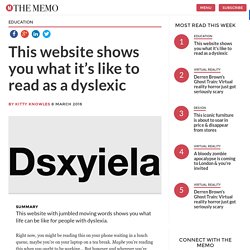
Not every dyslexic person will experience reading in a way akin to Widell’s code. Some people commented that the text made it too easy: “Leaving the first and last letter of a word stable makes it too easy. Being dyslexic is hard. Really hard.” Others were simply grateful to Widell for shining a light on their struggles: “Thank you for sharing I hope others will see how it feels for us.” The full unscrambled text on Widell’s website reads: “A friend who has dyslexia described to me how she experiences reading.
Great Lessons 4: Differentiation. One Size Does Not Fit All The aim of this series of posts is to focus on the habits of excellent practice; our default mode.
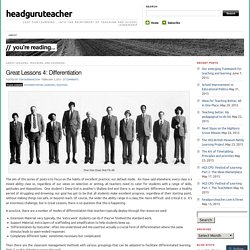
As I have said elsewhere, every class is a mixed ability class so, regardless of our views on selection or setting, all teachers need to cater for students with a range of skills, aptitudes and dispositions. One student’s Deep End is another’s Shallow End and there is an important difference between a healthy period of struggling and drowning; our goal has got to be that all students make excellent progress, regardless of their starting point, without making things too safe, or beyond reach.
Of course, the wider the ability range in a class, the more difficult and critical it is. It’s an enormous challenge, but in Great Lessons, there is no question that this is happening. In practice, there are a number of modes of differentiation that teachers typically deploy through the resources used: Different Grouping strategies.
Regulations and Guidance - JCQ Joint Council for Qualifications. Inclusion, Equality, Diversity, Differentiation. Guidance on how to improve equality and diversity practices The Learning and Skills Improvement Service (LSIS) and LSC have jointly published guidance for FE colleges and providers, to help them to self-assess equality and diversity.
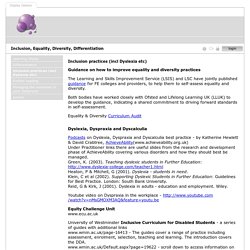
Both bodies have worked closely with Ofsted and Lifelong Learning UK (LLUK) to develop the guidance, indicating a shared commitment to driving forward standards in self-assessment. Equality & Diversity Curriculum Audit. World of Inclusion – Resources. International General Inclusive Education Altogether Better Published in association with Comic Relief.
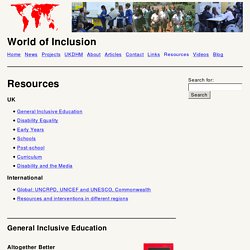
A comprehensive resources pack covering the issues surrounding Inclusive Education – aimed at teachers, school governors and others. 56 pages. download pdf Altogether Better video – download by chapter. Tomlinson-96.pdf. Inclusive Learning and Teaching - Inclusive - Resources - Strategy and Development - LeTS. British Dyslexia Association. University Disability Officers offer specialist advice about all aspects of support.
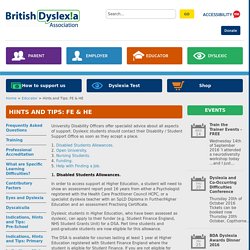
Dyslexic students should contact their Disability / Student Support Office as soon as they accept a place. 1. Disabled Students Allowances. 2. Education: meeting the needs of students in FE and HE. Inclusive Instruction: Evidence-Based Practices for Teaching Students with ... - Mary T. Brownell, Sean J. Smith, Jean B. Crockett, Cynthia C. Griffin. Is Irlen for you? - Irlen Central England Limited.
Irlen has a patented treatment-method which uses specially formulated, coloured overlays or coloured lenses worn as glasses or contact lenses to reduce or eliminate perception difficulties.
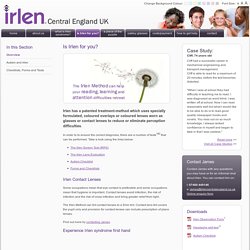
In order to to ensure the correct diagnosis, there are a number of tests1&2 that can be performed. Take a look using the links below: Irlen Contact Lenses. Creating an Effective Learning Environment for Asperger’s and HFA Students: Tips for Special Education Teachers. Many special education teachers are encountering students with Asperger’s (AS) and High Functioning Autism (HFA) for the first time – and have expressed some anxiety about this.
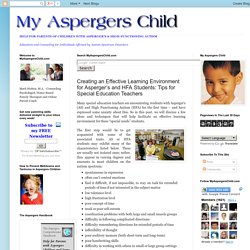
So in this post, we will discuss a few ideas and techniques that will help facilitate an effective learning environment for these “special needs” students. The first step would be to get acquainted with some of the associated traits. AS or HFA students may exhibit many of the characteristics listed below. These are usually not isolated ones; rather, they appear in varying degrees and amounts in most children on the autism spectrum: Special education teachers use varied strategies to help promote learning.
The terms accommodations and modifications do not mean the same thing. An accommodation is “a change that helps the child overcome - or work around - the deficit.” What is inclusion? The Index for Inclusion (Booth and Ainscow 2011, 3rd edition) summarises some of the ideas which make up the view of inclusion within the Index as follows: Inclusion in education involves: Putting inclusive values into action.Viewing every life and every death as of equal worth.Supporting everyone to feel that they belong.
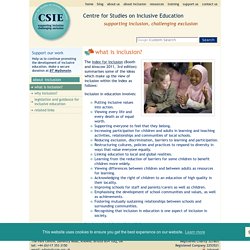
Increasing participation for children and adults in learning and teaching activities, relationships and communities of local schools. Reducing exclusion, discrimination, barriers to learning and participation.Restructuring cultures, policies and practices to respond to diversity in ways that value everyone equally. Alliance for Inclusive Education. Barriers_chart.png (PNG Image, 583 × 430 pixels) Equal opportunities and diversity: support guides - Directorate of Human Resources. Education: meeting the needs of students in FE and HE. British Dyslexia Association. Dyslexia is a recognised disability under the Equality Act (2010) which requires organisations to ensure that people with disabilities are not treated unfavourably and are offered reasonable adjustments.
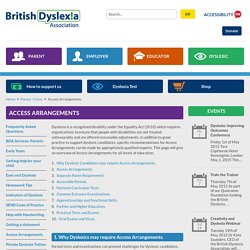
In addition to good practice to support dyslexic candidates, specific recommendations for Access Arrangements can be made by appropriately qualified experts. This page will give an overview of Access Arrangements for all levels of education. 1. Why Dyslexics may require Access Arrangements. Formal tests and examinations can present challenges for dyslexic candidates. Speed of processing, organising information, sequencing, short term and working memory, reading accuracy and automaticity and fluency in writing can all be particular issues preventing the dyslexic candidate from achieving their potential. [Return to top] 2. Legislation and guidance for inclusive education.
The law supporting inclusive education in the UK Legislation in the UK prohibits discrimination in education and supports inclusive education.
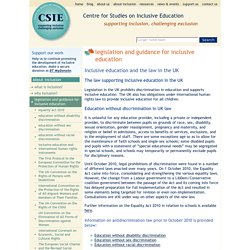
The UK also has obligations under international human rights law to provide inclusive education for all children. Education without discrimination in UK law It is unlawful for any education provider, including a private or independent provider, to discriminate between pupils on grounds of race, sex, disability, sexual orientation, gender reassignment, pregnancy and maternity, and religion or belief in admissions, access to benefits or services, exclusions, and in the employment of staff.
11 tips for communicating with a deaf child. If you’ve never communicated with a deaf child before you may feel nervous about how to do it. But don't worry - it’s not as hard as you think! It’s important to understand that every deaf child is different – with different levels of deafness, hearing equipment and communication preferences but the tips below are useful for communicating with all deaf children. 1. Find out how they communicate Not all deaf children use British Sign Language (BSL). 2.
To get a deaf child’s attention you can wave, knock a table, or tap their shoulder lightly.